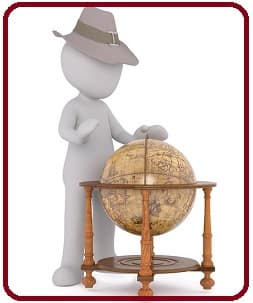| Back to Back Issues Page |
 |
|
The real-life Indiana Jones #129 May 21, 2019 |
The real-life Indiana JonesHave you ever wondered how George Lucas came up with the idea for Indiana Jones? While examining the adventures of early archeologists, I kept running into speculation about which of them might have inspired a character like him. Role Models for Indiana Jones?The first article considers the evidence that the producers of Indiana Jones, or more likely of the earlier adventure movies that inspired the series, based their swashbuckling hero on Hiram Bingham (the history professor who ‘discovered’ Machu Picchu.)The article features a photo of Bingham next to one of Jones. In Bingham’s determined expression (as well as his fedora and camp jacket), you can catch a glimpse of the kind of explorer Indiana Jones would be. The second looks at Roy Chapman Andrews. He was an early-twentieth-century explorer and naturalist for New York’s American Museum of Natural History. He is famous for discovering the first dinosaur eggs ever found (along with dinosaur bones and more) in the bleak Gobi Desert of Mongolia and western China. He was also an excellent shot—a skill that proved very useful during his expeditions. He had a number of narrow escapes: an attack by wild dogs, falls from cliffs, and poisonous snakes that tried to move into the expedition’s tents to escape the cold. The article describes in detail a close call with bandits. Andrews could see them waiting for him at the bottom of a hill, but he couldn't turn around on the steep road. "So what did Andrews do? In true Indiana Jones form, he decided the best course of action was to plough straight through the rifle carrying men at great speed." His plan worked. He frightened the bandits' horses, and most raced away before the astonished men could shoot. Andrews shot the hat off the one who remained—who escaped as quickly as he could, empty-handed. So which of these adventurers (or a few others that have been proposed) was THE inspiration for Indy? George Lucas and the other producers don’t say. However, they acknowledge a debt to the adventure movies of the 1930s. Those movies were likely based on a combination of these academic-action men. How Indiana Jones Affected ArcheologyNational Geographic provides evidence that Indiana Jones contributed to an increased interest in the profession of archeology.The article describes a museum exhibit featuring objects and clips from the Indiana Jones movies and some actual archeological discoveries that may have helped inspire the films. The Indiana Jones series, in turn, excited a new generation of would-be explorers and scientists. One of the series' actors wrote "'I must have met at least 150 or 160 full professors, lecturers, practising archaeologists who have come up to me to say their first interest in archaeology began when they saw Raiders of the Lost Ark.'"
Adventure VocabularyIf you didn’t have a chance to look at the crossword on archeology last week, try it now. This issue reviews much of the same vocabulary. (Click here for the answers.)A few new words: Bandits are armed robbers who usually work in groups. They often attack travelers passing through thinly-settled or isolated areas. Dinosaurs are large ancient reptiles (lizard-like creatures.) They no longer exist, so people have imagined what they were like based on their bones. An exhibit is a display of a group of objects: paintings or other artwork, documents, historical or cultural artifacts (objects that help show what the people of that time or place made or did), etc. An expedition is a trip by a group of people (scientists, soldiers, etc.) for a defined purpose. To fund is to provide money for a project or organization. Museums and expeditions require funding, and often get it by publicizing dramatic or new discoveries. I hope to provide some links and practical tips for writing in English (and for teaching writing in ESL classes) in the next issue of English Detective. Warmly, Catherine Simonton, EnglishHints.com P.S. If you don’t like to open links in emails, you can go to the EnglishHinks Back Issues page and open them there. It’s https://www.englishhints.com/English_Detective-backissues.html A note if you get gmail: Have you missed any issues of English Detective? if you find English Detective in your Promotions box, you can move it to your Primary box (if you want) by clicking on it and dragging it there, then clicking Yes when asked if you want to always get it in the Primary box. If you are not already getting English Detective, you can subscribe by completing the form here. (It's free!) Also, you can reach me by mail at 1752 Driftwood Drive, El Centro, CA 92243, USA. |
| Back to Back Issues Page |
